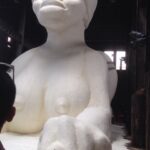From cut-out paper silhouettes to seventy-foot sugar sculptures, it’s still the history of…
Kara Walker, an artist adored by many, pisses off a fair number of people. Not that she cares. I’ve been following Walker since the ’90s, and I’m one of the adorers, not always of the work itself—although often so—and not always of the dialogue she creates—ditto there, too. But the girl is always willing to walk that fractured edge that could split her wide open—personally or professionally. God, how I love that.
For a couple of months this spring into summer, her first major installation, Subtlety, or the Marvelous Sugar Baby, inhabits Brooklyn’s Domino Sugar Refinery, rusted and ruined and still leaking molasses down its walls although it’s been shuttered for ten years after a 132-year run. The refinery is at South 3rd Street on the waterfront in Williamsburg, but as soon as the show comes down in early July, the huge building where trillions of tons of sugar were refined (that means transformed from brown to white—aaahhhh, that!) will be demolished to make way for swanky high-rises, yup, on the waterfront. Now that’s where I think the story really takes off.
So much of our stories are hidden, buried, dismissed, and so here we are in this extraordinary building—with fifteen five-foot-tall “black” and “brown” boys (each with a hint of a smile) made of resin, and a seventy-foot-long, thirty-five-foot-tall sphinx-like Aunt Jemima coated in eighty tons of white sugar. Damn. Other than what is written on the outside of this raggedy building when you queue up, you have nothing but the boys and the big mama to guide you—no paperwork, no plaques on the wall, no handouts. And so you know the vast majority of people don’t have a clue what’s up. Assumption? I don’t think so. Most of them are too busy taking photographs—sometimes of the work but mostly of their friends with the work (to post somewhere) or of themselves (to post somewhere). The posting is a given since they’re smiling and posing.
I’m sure there’s some reason I have yet to figure out as to why Walker paired up with the organization that would be tearing down the refinery, building the high-rises (they funded the exhibit). I’m sure there’s a reason that she agreed to not providing us with some background information. Just think of what could have been there: the history of sugar plantations (they commissioned papers from Edwidge Danticat and Shalja Patel and Jean-Euphele Milce about sugar and domination, cane laborers in the Dominican Republic, Haiti, and Kenya but not in the U.S., and only put them, obscurely in my opinion, on the arts website that’s connected to the developer). We’re missing all those facts about Domino, including how right there in Brooklyn the company employed 4,000 workers, processing 3 million pounds of sugar a day, supplying the country with almost all of its sugar; and, yup, we’re missing the fact that the property will be transformed into some kind of upscale development. It begs the question as to who will be disenfranchised now, and who’s supporting that disenfranchisement? Is she? Are we?—being there, publicizing the whole thing just as the high-rise project is approved. Convenient timing.
Hours after I left the refinery, I found myself in a tense conversation with a young artist. The minute I’d said we’d just come from the Walker and I said how powerful it was, he was debating the merits of Walker’s work and all the attention it/she gets, and that she needs to get over talking about “it” through that lens, in that way, with that bite. The “it” is the whole race thing. Let’s set this straight: Walker is black, the young artist is black, and honestly I am the one who does at times feel as if to move on people have to stop reliving the victim story—whatever victim story it is. But I’ve never felt that way about Walker.
Walker is a keeper of our history, of that I’m sure, and yet, she’s always, always giving us a way to resee, to remake, to redo, to reimagine the possibilities. Take a chance, she says. Dig in, speak up, what the hell do you really see/feel/understand/want/unwant? she challenges. Much of her previous work employs cut-out silhouettes, resonating with racial stereotypes. She has said, “The silhouette says a lot with very little information, but that’s also what the stereotype does.” So maybe she intends for us to be on our own here—each making the walk with little information. The gigglers and selfie-takers as much a valid part of the story as those who are trying to connect the pieces she hands us.
Kara Walker is going after something other than the obvious—that something is often muddy, indefinable, but if we’re paying attention, we will struggle along (we almost have no choice) to try to figure out how this story is ours—because it is. In everything Walker, there’s repression, there’s power, there’s race, there’s gender, there’s sexuality, frustration and loss and heartbreak.
But I am convinced that in everything Walker, there is also joy. Really there is—even if no one else has ever linked that word to her work.



